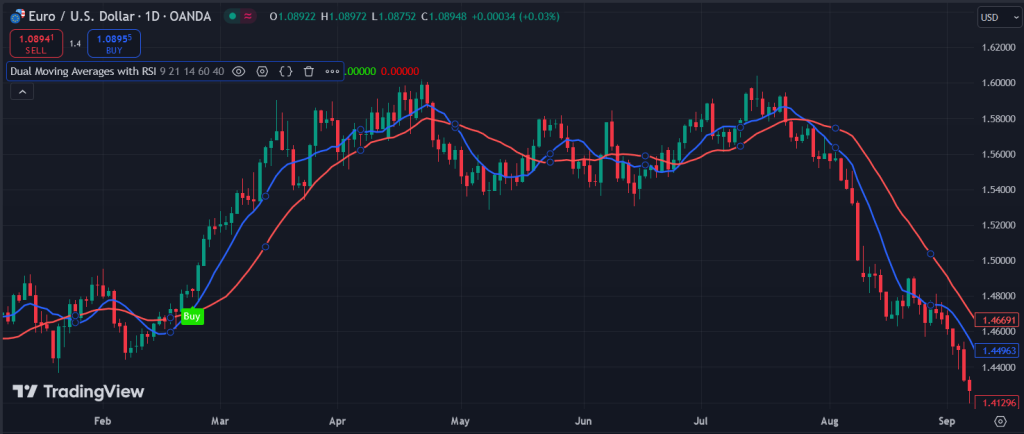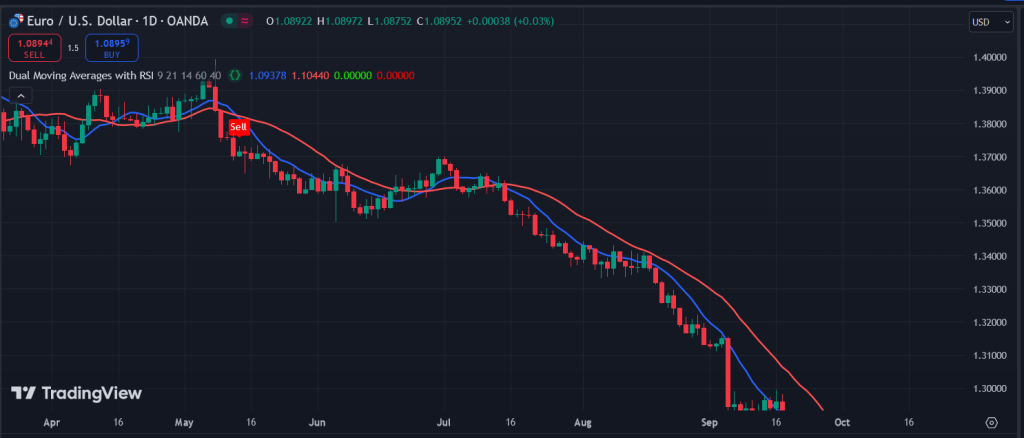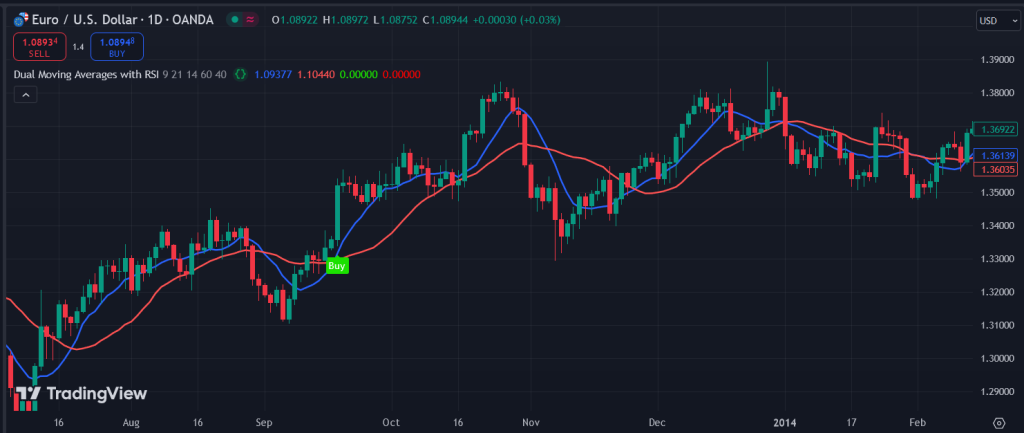🔓 Get All Tools for FREE!
- ✅ Click here to open a trading account using our referral link and start trading.
- 📅 After 7 days of active trading under our referral link, you can get access to all tools in your account.
- ⚠️ Keep trading to keep access free — if you're inactive for 7 days, your access will be removed.
- 👉 Already have an account? You can change the IB (introducing broker) to our referral link ( https://one.exnesstrack.org/a/w7syl3vnjb ) and still qualify!
In the fast-paced world of trading, having the right tools at your disposal is crucial for making informed decisions. Among the many indicators available, the Dual Moving Averages with RSI indicator stands out for its ability to combine trend-following and momentum analysis into one powerful tool. Whether you are a seasoned trader or just starting, understanding how to utilize this indicator can significantly enhance your trading strategy.
Understanding Moving Averages and RSI
Before diving into the specifics of the Dual Moving Averages with RSI indicator, it’s essential to grasp the fundamental concepts of moving averages and the Relative Strength Index (RSI).
🔓 Get All Tools for FREE!
- ✅ Click here to open a trading account using our referral link and start trading.
- 📅 After 7 days of active trading under our referral link, you can get access to all tools in your account.
- ⚠️ Keep trading to keep access free — if you're inactive for 7 days, your access will be removed.
- 👉 Already have an account? You can change the IB (introducing broker) to our referral link ( https://one.exnesstrack.org/a/w7syl3vnjb ) and still qualify!
What Are Moving Averages?
Moving averages are commonly used in technical analysis to smooth out price data over a specific period. They help traders identify trends by reducing noise and volatility in price movements. There are two main types of moving averages:
- Simple Moving Average (SMA): This is calculated by taking the arithmetic mean of a set of prices over a specific time frame. It provides a clear view of the average price over that period.
- Exponential Moving Average (EMA): Unlike the SMA, the EMA gives more weight to recent prices, making it more responsive to price changes. This characteristic makes it particularly useful in fast-moving markets.
What is the Relative Strength Index (RSI)?
The RSI is a momentum oscillator that measures the speed and change of price movements. It ranges from 0 to 100 and is typically used to identify overbought or oversold conditions in a market. Here’s how to interpret the RSI:
- Above 70: The asset is considered overbought, suggesting a potential price reversal or pullback.
- Below 30: The asset is deemed oversold, indicating a possible price increase or rebound.

The Dual Moving Averages with RSI Indicator
Now that we understand the basics of moving averages and RSI, let’s delve into how the Dual Moving Averages with RSI indicator works. This indicator combines two moving averages (usually a short-term and a long-term) with the RSI to provide comprehensive trading signals.
How It Works
- Signal Generation: The indicator generates buy and sell signals based on the interaction between the two moving averages and the RSI.
- Buy Signal: A buy signal occurs when the faster moving average crosses above the slower moving average, and the RSI is above 60. This suggests strong upward momentum and a favorable market condition for entering a long position.
- Sell Signal: Conversely, a sell signal is triggered when the faster moving average crosses below the slower moving average while the RSI is below 40. This indicates a bearish trend and can signal traders to exit their positions or consider shorting.
- Filtering Noise: By using two moving averages, the indicator helps filter out false signals that can often occur with single moving average strategies. This dual approach provides more reliable signals by confirming trends rather than reacting to every price fluctuation.
- Enhanced Decision-Making: The combination of moving averages and RSI not only helps traders identify entry and exit points but also allows them to gauge the strength of the trend. This added context is invaluable in making well-informed trading decisions.
Setting Up the Indicator on TradingView
Using the Dual Moving Averages with RSI indicator on TradingView is straightforward. Here’s a step-by-step guide to get you started:
- Access TradingView: Log into your TradingView account or sign up if you don’t have one yet.
- Add the Indicator:
- Click on the “Indicators” button at the top of your TradingView chart.
- In the search bar, type “Dual Moving Averages with RSI.”
- Click on the indicator to add it to your chart.
- Customize Settings: After adding the indicator, you can customize the settings to suit your trading preferences:
- Adjust the time periods for the moving averages (e.g., 9-period and 21-period).
- Set the RSI period, commonly 14, to align with your trading strategy.
- Analyze the Chart: Once set up, the indicator will display the two moving averages and the RSI. Observe the crossings and RSI levels to identify potential buy and sell signals.
Strategies for Using the Indicator
Incorporating the Dual Moving Averages with RSI indicator into your trading strategy can enhance your market analysis. Here are some strategies to consider:
- Confirmation of Trends: Use the indicator to confirm trends identified by other technical analysis tools. For instance, if your chart shows a bullish trend and the indicator generates a buy signal, it reinforces your decision to enter a long position.
- Diversify Entry Points: Combine this indicator with other indicators, such as MACD or Stochastic, to diversify your entry points and improve the accuracy of your trades.
- Risk Management: Always pair your trading signals with a solid risk management strategy. Set stop-loss orders to minimize potential losses and protect your capital.
- Regular Review: Markets are dynamic, and strategies that worked in the past may not be effective in changing conditions. Regularly review your trades and adjust your strategies based on the performance of the Dual Moving Averages with RSI indicator.


Conclusion
The Dual Moving Averages with RSI indicator is a powerful tool that can simplify your trading decisions and improve your overall strategy. By combining the strengths of moving averages and the momentum insights from RSI, traders can effectively identify potential entry and exit points while filtering out market noise.
Here’s a disclaimer you can use for your content:
Disclaimer: The information provided in this video/article is for educational purposes only and does not constitute financial advice. Trading in financial markets involves significant risk and may not be suitable for all investors. Past performance is not indicative of future results. Always conduct your own research and consider your financial situation before making any investment decisions. The use of the Dual Moving Averages with RSI indicator does not guarantee profits, and the creator is not responsible for any losses incurred as a result of using this information. Please consult with a qualified financial advisor before engaging in any trading activities.

0 Comments